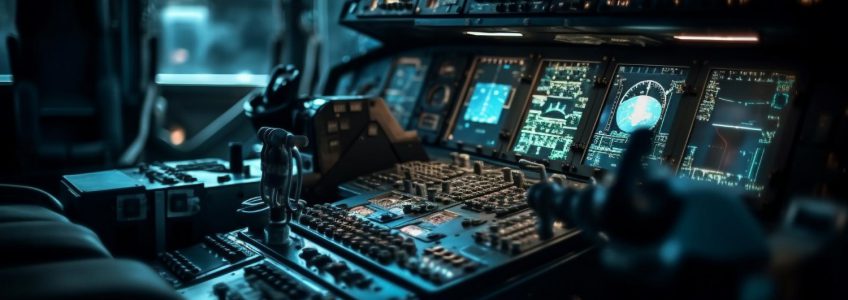
Printed circuit boards (PCBs) used in aerospace applications must be highly reliable, leaving no margin for error. They must last a long time while being used non-stop in challenging and extreme operating conditions. Unlike most traditional PCBs, ones used in aerospace applications must withstand intense environmental conditions, radiation, chemicals, contaminants, and more.
Aerospace circuits must meet strict standards, including the IPC-A-610E Class 3, which covers high-performance electronic devices that must operate continuously, without interruption, in the most difficult conditions. Some of the applications falling within the IPC-A-610E Class 3 standards are:
- Satellite communication systems
- Navigation systems
- Control systems
- On-board avionic instrumentation
- Applications for processing data on the ground recorded during flights
- Passive detection systems
- Unmanned aerial vehicles (UAVs)
- And more.
This guide explains what you must know to design circuits that can withstand the extreme conditions — and wear and tear — they will experience in aerospace applications.
1. Use Top Quality Materials
Reliability and durability are two non-negotiable requirements for circuits built for use in the aerospace industry. Typically, PCBs must operate continuously for 15 years or more. It’s critical to use high-quality materials that are time-tested.
In many aerospace PCBs, anodized aluminum is used instead of copper because it can help resolve many issues related to heat dissipation. Anodized aluminum delivers a thermal conductivity that is five to ten times higher than traditional materials like FR-4, with ten times less thickness. In addition, it can transfer heat much more efficiently than conventional PCBs. Plus, it significantly reduces the effects of heat-induced oxidation.
2. Leverage Heavy Copper Technology
Heavy copper technology, with copper thicknesses ranging from 2 to 6 oz/ft or more, allows heat to dissipate naturally. No additional cooling systems are necessary, even with high-intensity currents.
Combining heavy copper solutions with thermal vias is often a good idea to further enhance heat dissipation.
3. Always Stick to Standards
Printed circuit boards used in aerospace applications must be designed to operate with minimal maintenance while meeting rigorous safety and quality standards.
To achieve this, designers and manufacturers of aerospace PCBs must follow industry standards. This includes the IPC 6012DS, an addendum to the IPC-6012D. It provides qualification and performance requirements for rigid printed circuit boards for aerospace applications. It’s often considered an enhanced version of the IPC Class 3 standard.
Also important is the AS/EN 9100 aerospace standard. It includes an array of regulations developed by the International Aerospace Quality Group (IAQG). It aims to improve quality and reduce risk in the aerospace sector. This standard has been adopted across the globe.
The AS/EN 9100 standard adds requirements developed specifically for the aerospace industry to the ISO9001 standard. Printed circuits designed and developed for aerospace applications must conform to this standard and be certified they do so.
4. Deliver Excellent Thermal Management
As already covered, PCBs for aerospace applications must ensure excellent heat dissipation without needing to use external heatsinks. In addition to heavy copper technology and thermal vias, solutions like Pyralux AP, FR408, and other metal materials and components can help with the issue. It’s also smart to separate components, which provides more space for heat to dissipate.
5. Take Advantage of Conformal Coating and Surface Finish
PCB finishing materials must withstand extreme aerospace operating conditions. Typical surface finish methods include:
- Electrolytic nickel gold
- Electroless nickel with immersion gold coating (ENIG)
- Chemical silver
- Hot air solder leveling (HASL)
- Lead-free HASL
Typical conformal coating protects against heat, humidity, vibration, and water. The application of conformal coating should be followed by application of acrylic-based spray. It helps protect the PCB from contamination or short-circuiting.
6. Follow Routing Best Practices
The size of PCB traces must be able to handle the maximum current load, ensuring heat dissipation in all operating conditions. For circuits with high-frequency signals, the angles on the traces must be less than 45 degrees. This supports the uniform and dependable transmission of the signal across the circuit.
Electronic components operating at low frequencies must be separated from those using higher frequencies. That’s because high frequencies often generate waveforms and disturbances that impact low-frequency component operation. These issues can degrade signal quality, compromising the effectiveness of applications depending on them.
Clock signals must have appropriate physical shielding by applying casings made of aluminum or similar materials. Rules must also be applied to limit the crosstalk phenomena that can happen between adjacent traces.
7. Use a Combination of Flex and Rigid-Flex PCBs as Appropriate
Flexible and rigid-flexible printed circuit boards are commonly used in satellite and avionics systems. However, compared to industrial or automotive applications, they are typically manufactured with polyimide instead of FR-4. This material can adapt to small spaces, is light and resistant to heat and chemical agents, and is highly durable.
Flex and rigid-flex PCBs are popular in the aerospace industry because they:
- Adapt to small spaces
- Provide high resistance to vibrations, shocks, temperature, and external agents
- Deliver excellent mechanical and electrical connection
- Are lightweight.
Rigid-flex PCBs combine rigid and flexible printed circuit boards. They are permanently connected. Using flex and rigid-flex printed circuit boards can be an ideal solution for challenging applications with space limitations. It provides a secure connection between the parts of the rigid-flex circuit, ensuring both polarity and contact stability and reducing the number of connectors needed.
PCBs for Aviation Applications: The Bottom Line
Printed circuit boards for the aerospace sector that must meet the IPC-A-610 Class 3 and 3A standards have to be designed to deliver high electrical reliability, especially in the most challenging operating conditions.
All aspects of the PCB design process — from selecting the most suitable materials to getting them certified — must be focused on continuous failure-free operation, which can be a significant challenge. Leverage the expert tips in this article to ensure you get everything right.
